W. EUGENE SMITH
W. EUGENE SMITH
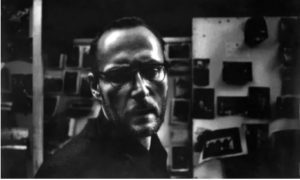
Stories include character, setting, and plot. A protagonist is the main character of a story, overcoming obstacles, propelling the story forward. W. Eugene Smith is a protagonist in the story of documentary photography. The setting is Japan, Colorado, Spain, South Carolina, and Pittsburgh. The plot is full of conflict and some resolution.
Conflict was something of a theme in Smith’s life, and I’m not referring solely to his war photography. According to O’Hagan, he was “unpredictable and self-sabotaging,” had “indomitable willpower,” and “railed against authority.” He was repeatedly fired from jobs or quit, an obsessive perfectionist, and addicted to alcohol and amphetamines. Despite all this, or maybe because of it, he is arguably “the single most important photographer in the development of the editorial photo essay.” It’s a bold claim, but not without merit.
Born in Kansas in 1918, Smith studied photography at the University of Notre Dame (he quit), then moved to New York City in 1938 to work as a photojournalist for prestigious magazines, including Newsweek, Time, Fortune, and Life. During World War II, he was a war correspondent for Life, taking pictures of U.S. Marines fighting in Japan. He was seriously wounded during the Battle of Okinawa; the injury required years of recovery.
In 1948, Life published The Country Doctor. Other photo essays followed, including Nurse Midwife in 1951.
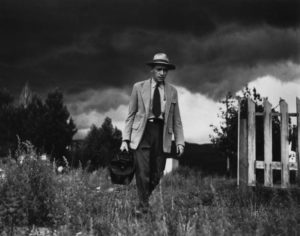
In 1954, Smith resigned from his position at Life over a disagreement about the layout of another photo essay.
Edward Steichen included four images by Smith in his 1955 Family of Man exhibit, including “The Walk To Paradise Garden,” depicting hope for the future of mankind, an antithesis of war.
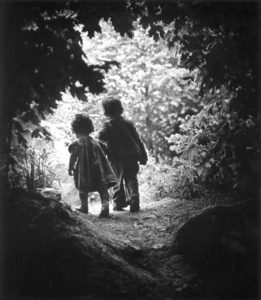
Smith joined Magnum in 1955 as an independent artist and accepted a job to photograph Pittsburgh. The assignment was to last three weeks, but became a three-year obsession, bankrupting Smith and almost bankrupting Magnum who oversaw his contract. Smith shot more than 11,000 photographs in five months and added 6,000 more in two subsequent trips. He edited the project down to 200 prints, but this was still too many to publish or display. Eventually, 88 images were printed in 1959. “His unrelenting dedication to the Pittsburg project,” argues Magnum, was “a testament to Smith’s devotion to photojournalism and commitment to… searching for the truth.” Of the project, Smith said, “It cost the lining of my stomach and much more besides… Other than that, Icarus, how was the flight?”
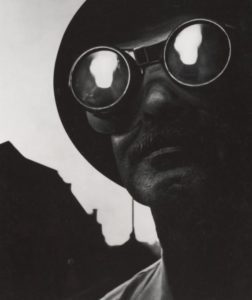
More work followed, including The Loft Project and his photo essay Minamata.
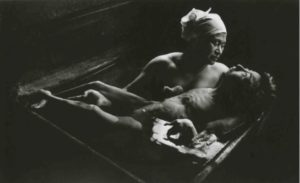
It’s impossible to do justice to Smith’s photographs in only a few paragraphs. His work, including over 100,000 negatives, is archived at the Univesity of Arizona’s Center for Creative Photography. Smith died of a stroke in Tucson, Arizona in 1978, aged 59 years.
Light, quite literally, makes a photograph, and Smith was a master of light. Indoors, he often used a single off-camera flash, positioned carefully to accent the natural light. Nor was he opposed to staging a scene. “Tomoko Uemura in Her Bath“ is both staged and lit. In an interview, Philippe Halsmann asked Smith about staging. “I don’t object to staging,” Smith said, “if I feel that it is an intensification of something that is absolutely authentic to the place.”
Stylistically, his prints are dominated by dark tones. “It was the brilliant, black drama of his photographs that made him famous – shafts of formal light through a chaotic dark” (Maddow).
Smith had strong ethics and believed in social justice. His photographs of nurse-midwife Maude Callen helped raise funds for a clinic, his Minamata pictures brought attention to mercury poisoning, and his war photography decried violence. “I frequently have sought out those who were in the least position to speak for themselves. By accident of birth, by accident of place – whoever, whatever, wherever – I am of their family. I can comment for them, if I believe in their cause, with a voice they do not possess.”
Smith immersed himself in his projects, spending extended time with his subjects (several weeks with Dr. Ceriani, the country doctor, three years in Pittsburgh, three years in Minamata). In Smith’s own words, he sought to “sink into the heart of the picture,” infusing the story “with a psychological depth and intricacy of narrative heretofore unprecedented in photojournalism” (Magnum).
Smith revolutionized the photo essay by integrating himself into the story. His work bridged journalism and art. For me, the most important legacy of Smith’s work is the humanity of his subjects.
Plots resolve and conflicts end. Smith’s inner conflict never quite resolved; his self-recrimination remained to the end. Later in life, he called his Pittsburgh project a “debacle” and “the finest set of photographs I have ever produced.” He was his finest critic, his own worst enemy, and a worthy protagonist.
